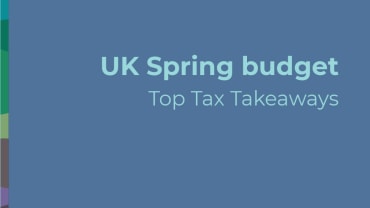It is rare for the set-piece of a Budget speech to be overshadowed by developments elsewhere. But such was the fate of Derek Mackay, where his second substantive Scottish Budget on 12 December 2018 seemed bound to take second place to the drama unfolding at Westminster, where the Prime Minister was fighting for her political life. He could not have anticipated this; and while there were indeed some "bigger" taxes to consider in what he announced, he announced them with a proud defiance, enthusing about the different path being taken by the Scottish Government where devolution allows a divergent route to open up. Not too divergent, but with sufficient distinctions to make a difference, according to Mr Mackay.
Of course, all that Mr Mackay could announce were proposals. His Government will require the support of at least one other party to get the proposals into law; and the price of that support might, as happened last year, involve accepting changes to what was announced as his policies. But the impressive document released as Mr Mackay sat down is entitled "Scottish Budget 2019-20" _ unlike its predecessors, which had "Draft" as part of their title. Perhaps Mr Mackay is feeling very confident of wider support. He did challenge those making any alternative proposals to his own to explain how they would be paid for.
The road to implementing changes also differs from Westminster, with no annual Finance Act to carry the Budget into effect. Some announcements will require at least secondary legislation (and therefore some delay); others will not require any legislation; while perhaps the announcement with the widest effects , on income tax rates for Scottish taxpayers, involves a Resolution by the Scottish Parliament.
Much of the Budget document is devoted to spending plans rather than to raising the money to pay for them _ a hangover from when the Scottish Parliament could really only control spending, not taxation. But when the full taxation powers currently devolved come into effect, almost half of the Scottish Government's spending will be raised from Scottish sources, whether by fully devolved taxes (such as Land and Buildings Transaction Tax), partially devolved taxes (such as income tax) or assigned taxes (such as half of the VAT raised by expenditure in Scotland). What follows is consideration of the more important tax developments from Scottish Budget 2019-20, with a small mention of the far more extensive spending plans mentioned.
Income tax
As is becoming better known, the devolution of income tax is restricted to the rates and thresholds for the tax as it applies to non-savings and non-dividend income (broadly employment, pensions, self-employment and rental income) of Scottish taxpayers. For 2018-19, a structure involving five rates for Scottish taxpayers on that income was announced. The proposal for 2019-20 maintains both that structure and the various rates; but alters for the first two rates the thresholds up to which they apply. These thresholds increase with inflation; but the thresholds at which the Scottish Higher Rate and Top Rate cut in are to be frozen. This would provide the following rates for different levels of affected income.
| Bands | Band name | Rate |
| Over £12,500-£14,549* | Starter Rate | 19% |
| Starter Rate | Scottish Basic Rate | 20% |
| Over £24,944-£43,430 | Intermediate Rate | 21% |
| Over £43,430-£150,000 | Higher Rate | 46% |
| Above £150,000** | Top Rate | 46% |
*Assumes individuals are in receipt of the Standard UK Personal Allowance.
**Those earning more than £100,000 will see their Personal Allowance reduced by £1 for every £2 earned over £100,000.
As was perhaps foreshadowed in announcements following the UK Budget in October, this means that the Scottish Government is not replicating the increase in the higher rate threshold to £50,000 announced for the rest of the UK.
This has some important knock-on effects. National Insurance thresholds are tied to the UK higher rate threshold _ this means that there would be a marginal rate of tax and NI totalling 53% on the "slice" of earned income between £43,430 and £50,000, as compared to 32% in the rest of the UK.
The overall effect will vary depending on a taxpayer's individual position. We are told that "...55% of income tax payers in Scotland will pay less tax than people earning the same wage in the rest of the UK...." (which presumably means that 45% will pay more or, in a few cases, the same). With the higher rate threshold frozen for a second year, the number of people paying more can only grow.
Here are comparative examples of the position for individuals with earnings of £25,000 and £50,000.

But whether this level of differentiation is enough to persuade Scottish Higher Rate taxpayers to contemplate trying to stop being Scottish taxpayers at all remains to be seen. It would not take too many of them making that decision to reduce the overall take for the Scottish Government.
Of course, as Mr Mackay was at pains to emphasise, there are spending decisions which will benefit those Scottish taxpayers paying increasingly more than their rUK counterparts. The archetypal beneficiary will be stuffing down free prescription pills, while transporting their student child back to a Scottish university, taking advantage of the Road Equivalent Tariff available from their island care home.
There may be some reassurance for the future in that the rather mysterious Council of Economic Advisers will be asked to extend their remit from a consideration of the Top Rate of tax to considering all income tax policy related behavioural effects and associated risks, and if necessary, what any mitigating actions may be. It is not clear whether the "mitigating actions" referred to are those of taxpayers, or of the Scottish Government in response to whatever taxpayers might do.
As a minor issue, it might be hoped that the proposals as eventually implemented might be altered to include rather more rounded levels for the first two thresholds, an environmental move to save calculator batteries or to reduce the need for bigger backs of envelopes when working out an individual's tax liability.
Land and Buildings Transaction Tax
Land and Buildings Transaction Tax (LBTT) is the most important substantive tax fully within the Scottish Parliament's control _ all rules and rates can be changed without reference to what may be happening elsewhere in the UK.
In a somewhat unexpected move (and coming out surprisingly early in Mr Mackay's speech, when he was generally talking about spending decisions), it was announced the Additional Dwelling Supplement (ADS - mainly on 2nd homes and buy-to-let properties but also on (for example) any residential property purchased by a company) is to increase from 3% to 4% from 25 January 2019.
It is nearly Christmas; and this must have appeared a fat goose that could do with a little more plucking. The figures for the impact of this tax are perhaps surprising _ between a quarter and a fifth of residential transactions are liable to ADS; and figures in the Budget documents indicate that with the increase, ADS will account for more than a third of the amount raised by "basic" LBTT. And with the new 4% ADS, the top rate of LBTT will now be a staggering 16% on the amount of the consideration above £750,000. As the tax applies only to the land and buildings element of a transaction, a reasonable attribution of as much as possible to other things being bought will be all the more attractive. The £20,000 carpet looms again....
Perhaps this is the Scottish government's response to the 1% SDLT surcharge proposed in the UK Budget for purchases of residential property by non-residents. Everyone will be treated as a non-resident for Scottish ADS purposes in terms of the rate they will pay, which removes what might have been a difficult and sensitive definitional problem.
At the upper end of residential transactions, the differential with the position in the rest of the UK has grown again, as the following table illustrates.
| CONSIDERATION | SDLT | SDLT + HRAD | LBTT | LBTT + ADS |
| £300,000 | £5,000 | £14,000 | £4,600 | £16,600 |
| £800,000 | £30,000 | £54,000 | £54,350 | £86,350 |
In another change taking effect from 25 January 2019 (legislation permitting), a new rate structure is introduced for non-residential purchases. The lower rate of non-residential LBTT is to be reduced from 3% to 1%, the upper rate increased from 4.5% to 5% and the starting threshold for the upper rate will be reduced from £350,000 to £250,000.
Here are the rates which will be in effect following the change:-
| Purchase price | LBTT rate |
| Up to £150,000 | 0% |
| Above £150,000 to £250,000 | 1% |
| Above £250,000 | 5% |
This is claimed to make Scotland the most "competitive" part of the UK for non-residential land transaction taxes _ but of course for large transactions the new top rate will have a greater effect than the reductions at the bottom end as compared with current LBTT rates. It is to be noted that the Scottish Government anticipates a rise in receipts from non-residential LBTT as a result of these changes. The following table illustrates the effects of the changes.
| Consideration | Old LBTT | New LBTT | SDLT |
| £250,000 | £3,000 | £1,000 | £2,000 |
| £500,000 | £12,750 | £13,500 | £14,500 |
| £1,000,000 | £35,250 | £38,500 | £39,500 |
The changes to ADS and non-residential rates of LBTT can be made by statutory instrument rather than primary legislation. The proposal to have legislation in place by 25 January 2019 represents legislative progress at the speed of light compared to some changes in the past, but the absence of the ability to make immediate changes by Budget resolution necessitates at least this degree of delay.
There was an announcement that there would be two new LBTT reliefs, this time replicating the position in the rest of the UK, in relation to "seeding" (the initial transfer) of properties into entities known as Property Authorised Investment Funds and Co-owned Authorised Contractual Schemes. There will also be a relief when units in CoACSs are exchanged. There is to be further consultation on these reliefs once there is sufficient clarity on the terms of the UK's withdrawal from the EU; subject to that the intention is for the new reliefs to be introduced in the course of 2019. This is an important matter for those in the property industry _ the current position means that Scottish property simply cannot be included in CoACSs. There are some recognised problems with the existing reliefs in the rest of the UK; and it probably makes sense to await their resolution before enacting what will be the Scottish equivalent.
Scottish Landfill Tax
Scottish Landfill Tax (SLfT) is the second of the devolved Scottish taxes, which means that the Scottish Government has control over the tax base as well as the rates and the tax is collected by Revenue Scotland, the Scottish tax authority. Although SLfT is modelled on Landfill Tax there are many significant differences. As expected the Scottish Government proposes to increase the standard rate of SLfT to £91.35 per tonne and the lower rate of SLfT to £2.90 per tonne in 2019-20, in line with RPI inflation and to ensure consistency with Landfill Tax charges in the rest of the UK. SLfT receipts are forecast to reduce over the next 5 years - very substantially from 2021-22 - as more and more waste is diverted from landfill (which is after all the aim of the tax!) It remains to be seen what will be done to replace the revenue from this particular filling of holes in the ground.
Aggregates Levy
Part of the answer to replacing revenue from filling holes may lie in the implementation of the devolution of a tax on making such holes _ Aggregates Levy. In a theme unchanged from last year's Budget, there are apparently ongoing legal issues in relation to the UK tax (in turn deriving from European considerations), which need to be resolved before the devolution of the tax can be completed. Research continues in anticipation of the tax being devolved; and further integration with waste and other environmental policies is specifically mentioned.
Air Departure Tax (Air Passenger Duty in the rest of the UK)
The framework for ADT has been created in the Air Departure Tax (Scotland) Act 2017. Various difficulties over State Aid (with particular reference to an exemption for the Highlands and Islands) mean that the introduction of the devolved tax is to be delayed; and this delay has already been announced as being "beyond April 2019" . There was a renewed commitment stated to reduce the impact of ADT by 50% and to abolish it entirely "when resources allow".
Non-domestic (Business) Rates
Responsibility for non-domestic rates is fully devolved to Scotland, and the regime continues to diverge from the position in the rest of the UK.
The amount of non-domestic rates paid is the rateable value of the property (ie its open market rental) multiplied by the "poundage". Rateable values are set at periodic revaluations; the last one for Scottish property was in 2017.
In response to widespread calls from Scottish business, the Scottish Government proposes a below-inflation increase in the non-domestic rates poundage for 2019-20 to 49p, which caps the increase at 2.1%. This means that 90% of properties will pay a lower poundage than in the rest of the UK.
In addition there is to be an enhanced 100 per cent fibre broadband relief for a 10 year period to 31 March 2029. Confirming previous announcements, there will be a continuation of the transitional relief for Aberdeen City and Shire offices and for hospitality properties across Scotland. The Scottish Government has shelved the idea to impose a levy on out of town retailers, which will be a welcome announcement to some.
Work is still going on to implement the recommendations of the Barclay Review and the Scottish Government confirms that legislation needed to implement some of the changes will be introduced in early 2019.
Value Added Tax Assignment
While VAT assignment, sadly, did not feature in Derek Mackay's budget speech, the fuller budget paper does contain some useful information on this subject. It is perhaps a shame that the term used is not the more appropriate Scottish legal term, assignation. In any event, for those of you who have _ quite forgivably _ not followed the minutiae of the developments in this area, a short summary follows.
The Scotland Act 2016 provides for 10 pence of the Standard Rate of VAT and 2.5 pence of the Reduced Rate to be assigned to the Scottish Government. The assignment of VAT is to be based on forecasts and final estimates of VAT receipts, ie spending in Scotland on goods and services that are liable for VAT. VAT receipts will be assigned to Scotland, and the block grant will be reduced accordingly.
This therefore includes no ability to influence the rate or indeed other rules of VAT. As an EU member, this in some ways made sense because the UK was not allowed to have different VAT rates in Scotland and the rest of the UK. Consequently, the UK's imminent departure from the EU will be of interest to advocates of the total devolution of VAT to Scotland.
It has been confirmed that the 2019-20 tax year will be a transitional year during which the VAT assignment will be forecast and calculated, but will have no impact on the Scottish Government's budget. While the coming year is therefore intended to be a dress rehearsal, we must all hope it will not be followed by a pantomime.
The draft model for determining Scottish VAT receipts was published in November 2018 and will be subject to finalisation in early 2019. The draft VAT assignment model is complex, but simply put, it forecasts the VAT on expenditure in Scotland by 'final consumers', which means consumers, businesses and other organisations who cannot recover any VAT they incur.
As set out in Scottish Budget 2019-20 provided both the Scottish and UK Governments are happy that the assignment methodology is effective, the assignment of VAT receipts to Scotland will begin in the 2020-21 tax year.
With 2020-21 VAT receipts for Scotland forecast at just under £6 billion _ representing over fifteen percent of Scotland's annual budget _ it is imperative that the system works properly. The confirmation in the Scottish Budget that there will be a full year of testing the methodology before there are any adjustments to the block grant is to be welcomed.
The Scottish Budget Process
Many commentators have focussed on the lack of an annual tax or finance act in the current Scottish tax landscape which makes it difficult to introduce technical tax changes which require primary legislation in any meaningful timescale. In its 2018 Programme for Government the Scottish Government committed to work closely with stakeholders to develop a new process for the planning, management and implementation of changes to the fully devolved taxes (ie LBTT and SLfT). This Scottish Budget confirms that a consultation will be launched in February 2019 and commits the Scottish Government to announcing the new process next year, in Scottish Budget 2019-20.
Contributors
Partner
Director of Corporate Tax












